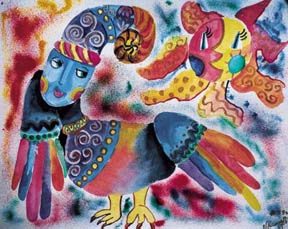|

Summer
1999 (7.2)
Page
12
Baku Diary:
The Colors
of the Future
by Jonelle
Glosch
  Whether you're new to
Azerbaijan or a regular old-timer, you can't help noticing that
this is a country that appreciates art. From carpets, to sculptures
and monuments, to ancient palaces like the Shaki Khan Palace,
Azerbaijan surrounds you with art. Whether you're new to
Azerbaijan or a regular old-timer, you can't help noticing that
this is a country that appreciates art. From carpets, to sculptures
and monuments, to ancient palaces like the Shaki Khan Palace,
Azerbaijan surrounds you with art.
What I didn't expect to see here was the large number of Azerbaijani
children training in the arts though it's only natural that they
would be. Many children take art lessons from an early age, often
as young as four or five years old.
Photo: Jonelle Glosch
I decided to talk to one such talented youth that I kept hearing
about. Although this story is about Natella Mammadova and her
family, it could be about any number of young artists. Natella's
parents, like so many others, nurture the artistic tendencies
in their children. Even though her parents are not artistic themselves,
they recognize her ability and make immense sacrifices to foster
their child's creativity.
Fostering Talent
I remember how my cousin in California started taking art classes
once she became 12 years old-the age her parents deemed mature
enough to be disciplined about work. After about a year, it was
considered sufficient. They felt their daughter had had enough
exposure to art and could get on with the "real subjects"
such as math, biology and chemistry that might eventually lead
to a career.
Art: Natella Mammadova,
12, "Fantasia", watercolor, 1999.
That's one major difference that I've noticed between the two
cultures in terms of education. In the U.S., there's a tendency
for people to dabble in a number of subjects and gain enough
exposure to become barely conversant. In Azerbaijan, a young
person is encouraged to learn a subject thoroughly.
During the Soviet period, the government sponsored the art schools,
and anyone who qualified could attend for free. These schools
are still in operation, but now they charge $20-60 each month.
(A public school teacher typically has a government salary of
about $20 per month.) For the more advanced levels of instruction,
the schools become more selective, nurturing specific students
in hopes of developing budding talents.
The most descriptive
word for Natella is "pixie". She looks like a little
doll: petite, impish and highly spirited. When I visited her,
she was wearing jeans and chewing gum like any American kid her
age. I found her a bit shy at first but when she started talking
about the landscapes and people she likes to paint, it was hard
to remember that she is still not even a teenager.
  Natella
has the longest light brown hair I've seen in quite a while-all
the better for braiding when she dons traditional costume and
dances the Azeri traditional national dances. She's part of a
dance troupe of considerable reputation, having traveled to Turkey
and Russia by invitation. She also plays the piano like many
kids her age in Baku. Natella
has the longest light brown hair I've seen in quite a while-all
the better for braiding when she dons traditional costume and
dances the Azeri traditional national dances. She's part of a
dance troupe of considerable reputation, having traveled to Turkey
and Russia by invitation. She also plays the piano like many
kids her age in Baku.
Art: Natella Mammadova's
family parrot, 1997.
On a typical day, Natella goes to school for the first shift
of classes studying from early morning until 1:00 p.m. Then she's
off to art school or dance or piano lessons. She's a busy kid
until late at night. She says she doesn't miss her friends because
they're enrolled in the same classes along with her.
Natella, like many of her friends, began her art training when
she was five years old. Her teacher, Tatiana Vladilenovna Kezar,
has introduced her to a whole range of art experiences, from
oil and watercolor painting to textile art. Natella works with
pen and ink, chalk, metallic paint and fabrics. Her subjects
vary and include the world of her imagination as well as people
from other cultures, abstract ink designs and Azerbaijani national
images.
By age seven, Natella already had enough quality artwork for
a personal exhibition. Her work was showcased at the Children's
Art Gallery in Baku. In addition, she was named a "Laureate"
in a competition sponsored by British Petroleum.
Exhibitions
Natella, now 12 years old, has created more than
80 paintings. She has participated in exhibitions in Azerbaijan
and Moscow and has been honored by several dignitaries, including
the Israeli Ambassador. At one exhibition, President Aliyev was
so impressed with one of the paintings that he inquired who the
artist was. It turned out to be Natella. Aliyev asked her to
organize paintings for a personal exhibition.
paintings. She has participated in exhibitions in Azerbaijan
and Moscow and has been honored by several dignitaries, including
the Israeli Ambassador. At one exhibition, President Aliyev was
so impressed with one of the paintings that he inquired who the
artist was. It turned out to be Natella. Aliyev asked her to
organize paintings for a personal exhibition.
Americans in Iowa found out about Natella when her older sister,
Sabina, went there as a high school exchange student through
the U.S. Freedom Support Program. Natella sent 40 of her paintings
for an exhibition to the art museum in Clarion. Visitors got
a chance to see Azerbaijani art and dance, hear Azerbaijani music
and even taste some local cuisine that Sabina had prepared.
The Future of Art
When I asked Olga Mammadova, Natella's mother, about the future
of artists in Azerbaijan, she became pensive. "Azerbaijani
parents," she said, "will do anything for their children.
They want them to develop into highly cultured individuals. If
a child wants to take art lessons, we gladly do our best to pay
for them."
  A
number of the foreign companies have sponsored art exhibits and
competitions as a way to encourage young artists. In June 1998,
the International Women's Club of Azerbaijan organized an event
to showcase Azerbaijani talent. Amoco recently published a book
of children's art that will provide support to orphans. A
number of the foreign companies have sponsored art exhibits and
competitions as a way to encourage young artists. In June 1998,
the International Women's Club of Azerbaijan organized an event
to showcase Azerbaijani talent. Amoco recently published a book
of children's art that will provide support to orphans.
Photo: Young artist Natella
Mammadova, 12, in traditional dance costume.
But according to Olga Khanim, these efforts still are far from
sufficient to keep young artists in Azerbaijan. At the same time,
she's cautious about encouraging her daughter to study abroad
in the years to come. She realizes the risks involved and the
enticement of staying abroad and not returning home. "Baku
needs its artists just as they need Baku," she says. As
long as Azerbaijan has a troubled economy, the bright talents
in Azerbaijan will be lured away by a more promising life abroad.
If they stay in Azerbaijan, they may even have to abandon art
in favor of what Natella's mom calls "paying jobs".
In the meantime, Natella's colorful works are appealing and full
of promise and optimism. Birds sing and flowers bloom. Reason
and order dominate her canvases. It's a vibrant world just like
the one her parents hope will be waiting for her when she grows
up.
Natella Mammadova's
paintings will be among those exhibited on the AZ Art Gallery
on the Internet organized by Azerbaijan International magazine.
Visit www.azer.com beginning in mid-summer 1999.
Jonelle Glosch has lived in Baku for the past three years and
is the Founder of Azerbaijan Business Services (ABS), which has
trained more than 250 young people in English communication and
international office practices.
From Azerbaijan International (7.2) Summer1999.
© Azerbaijan International 1999. All rights reserved.
Back to Index
AI 7.2 (Summer 99)
AI Home
| Magazine
Choice | Topics
| Store
| Contact
us
|




